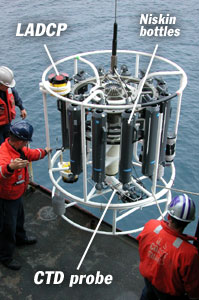 |
CTD
CTD is an acronym for the parameters that this device measures: “Conductivity, Temperature, and Depth.” The CTD itself is a set of small probes attached to a large metal rosette wheel (see image). The rosette is lowered on a cable down to the seafloor, and scientists observe the water properties in real time via a conducting cable connecting the CTD to a computer on the ship. The water temperature and salt content, or salinity (which is computed from the conductivity), is important to oceanographers because it tells us about the types of water masses present, and how they are moving in the ocean. There can also be a host of other acessories and instruments attached to the CTD package. These include Niskin bottles (shown in image) which collect water samples at discrete depths for measuring chemical properties, Acoustic Doppler Current Profilers that measure the horizontal velocity, and oxygen sensors that measure the dissolved oxygen content of the water. On our cruise we will be using a SeaBird 911 CTD.